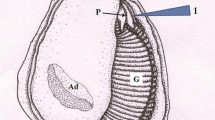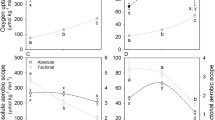Abstract
Survival of Ctenodiscus crispatus during exposure to hypoxia (P O 2<3 mm Hg) at 5°C is greater than that of any echinoderm reported in the literature, the LT50 being 248 h; this is reduced to 236 h in the presence of hydrogen sulfide. Unlike Asterias vulgaris and A. forbesi, both of which lose the tube foot response to tactile stimulation long before death from hypoxia occurs, C. crispatus remains responsive until death. The extension of the highly protrusible epiproctal cone, which occurs in 75% of the mud stars simultaneously exposed to hypoxia and H2S, serves to maintain burrow contact with the overlying water. The rate of oxygen consumption remains constant down to an ambient oxygen partial pressure of 10 to 25 mm Hg, becoming more oxygen-dependent after prior exposure of the asteroids to hypoxia. C. crispatus exhibits a clear oxygen-debt phenomenon as well as a compensatory reduction in the residual P O 2 (oxygen partial pressure at which oxygen consumption ceases) from 2.4 to 0.2 mm Hg after hypoxic exposure.
Similar content being viewed by others
Literature cited
Alton, M.S.: Bathymetric distribution of sea stars (Asteroidea) off the northern Oregon coast. J. Fish. Res. Bd Can. 23, 1673–1714 (1966)
Bayne, B.L.: Oxygen consumption by three species of lamellibranch mollusc in declining oxygen tension. Comp. Biochem. Physiol. 40A, 955–970 (1971)
—: The responses of three species of bivalve mollusc to declining oxygen tension at reduced salinity. Comp. Biochem. Physiol. 45A, 793–806 (1973)
Belman, B.W. and A.C. Giese: Oxygen consumption of an asteroid and an echinoid from the Antarctic. Biol. Bull. mar. biol. Lab., Woods Hole 146, 157–164 (1974)
Christensen, A.M.: Feeding biology of the seastar Astropecten irregularis Pennant. Ophelia 8, 1–134 (1970)
Clark, R.B.: Dynamics in metazoan evolution. The origin of the coelom and segments, 313 pp. London: Oxford University Press 1964
Cowen, R.: Respiration in metazoan evolution. Evolution 27, 696–701 (1974)
Ellington, W.R.: Holothurian facultative anaerobiosis. Am. Zool. 15, p. 808 (1975a)
— Glucose degradation and respiratory metabolism in starfish tissue. Fedn Proc. Fedn Am. Socs exp. Biol. 34, p. 466 (1975b)
— and J.M. Lawrence: Malic and lactic dehydrogenase activities and ratios in regular and irregular echinoids (Echinodermata). Comp. Biochem. Physiol. 45B, 727–730 (1973)
Fenchel, T.M. and R.J. Riedl: The sulfide system: a new biotic community underneath the oxidized layer of marine sand bottoms. Mar. Biol. 7, 255–268 (1970)
Fisher, W.K.: Asteroidea of the North Pacific and adjacent waters. Part I. Phanerozonia and Spinulosa. Bull. U.S. natn. Mus. 76, 1–419 (1911)
Grainger, E.H.: Sea stars (Echinodermata: Asteroidea) of arctic North America. Bull. Fish. Res. Bd Can. 152, 1–70 (1966)
Guenther, W.C.: Analysis of variance, 199 pp. Englewood Cliffs, New Jersey: Prentice-Hall Inc. 1964
Johansen, K. and J.A. Petersen: Gas exchange and active ventilation in a starfish, Pteraster tesselatus. Z. vergl. Physiol. 71, 365–381 (1971)
— and R.L. Vadas: Oxygen uptake and responses to respiratory stress in sea urchins. Biol. Bull. mar. biol. Lab., Woods Hole 132, 16–22 (1967)
Kushins, L.J. and C.P. Mangum: Responses to low oxygen conditions in two species of the mud snail Nassarius. Comp. Biochem. Physiol. 39A, 421–435 (1971)
Lieberkind, I.: Asteroidea. I. Porcellanasteridae. Dan. Ingolf-Exped. 4, 1–37 (1935)
Mangum, C.P.: Respiratory physiology in annelids. Am. Scient. 58, 641–647 (1970)
— and W. Van Winkle: Responses of aquatic in vertebrates to declining oxygen conditions. Am. Zool. 13, 529–541 (1973)
Mortensen, Th.: Handbook of the echinoderms of the British Isles, 471 pp. Edinburgh: Oxford University Press 1927
Oertzen, J.-A. von: Abiotic potency and physiological resistance of shallow and deep water bivalves. Oikos (Suppl.) 15, 261–266 (1973)
Sassaman, C. and C.P. Mangum: Adaptations to environmental oxygen levels in infaunal and epifaunal sea anemones. Biol. Bull. mar. biol. Lab., Woods Hole 143, 657–678 (1972)
——: Relationship between aerobic and anaerobic metabolism in estuarine anemones. Comp. Biochem. Physiol. 44A, 1313–1319 (1973)
Scheid, M.J. and J. Awapara: Stereospecificity of some invertebrate lactate dehydrogenases. Comp. Biochem. Physiol. 43B, 619–629 (1972)
Sokal, R.R. and F. J. Rohlf: Biometry. The principles and practice of statistics in biological research, 776 pp. San Francisco: W.H. Freeman & Company 1969
Stephens, G.C.: Uptake of naturally occurring primary amines by marine annelids. Biol. Bull. mar. biol. Lab., Woods Hole 149, 397–407 (1975)
Tang, P.S.: On the rate of oxygen consumption by tissues and lower organims. Q. Rev. Biol. 8, 260–274 (1933)
Taylor, A.C. and A.R. Brand: Effects of hypoxia and body size on the oxygen consumption of the bivalve Arctica islandica (L.). J. exp. mar. Biol. Ecol. 19, 187–196 (1975)
Theede, H.: Comparative studies on the influence of oxygen deficiency and hydrogen sulphide on marine bottom invertebrates. Neth. J. Sea Res. 7, 244–252 (1973)
—, A. Ponat, K. Hiroki and C. Schlieper: Studies on the resistance of marine bottom invertebrates to oxygen-deficiency and hydrogen sulphide. Mar. Biol. 2, 325–337 (1969)
—, J. Schaudinn and F. Saffé: Ecophysiological studies on four Nereis species of the Kiel Bay. Oikos (Suppl.) 15, 246–252 (1973)
Turner, R.L.: Skeletal morphology and general anatomy of the mud star, Ctenodiscus crispatus (Echinodermata: Asteroidea), 164 pp. Master of Science thesis, University of Maine, Orono 1971
— and J.H. Dearborn: Skeletal morphology of the mud star, Ctenodiscus crispatus (Echinodermata: Asteroidea). J. Morph. 138, 239–262 (1972)
Van Winkle, W. and C. Mangum: Oxyconformers and oxyregulators: a quantitative index. J. exp. mar. Biol. Ecol. 17, 103–110 (1975)
Webster, S.K. and A.C. Giese: Oxygen consumption of the purple sea urchin with special reference to the reproductive cycle. Biol. Bull. mar. biol. Lab., Woods Hole 148, 165–180 (1975)
Author information
Authors and Affiliations
Additional information
Communicated by M.R. Tripp, Newark
Rights and permissions
About this article
Cite this article
Shick, J.M. Physiological and behavioral responses to hypoxia and hydrogen sulfide in the infaunal asteroid Ctenodiscus crispatus . Mar. Biol. 37, 279–289 (1976). https://doi.org/10.1007/BF00387613
Accepted:
Issue Date:
DOI: https://doi.org/10.1007/BF00387613




